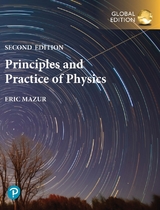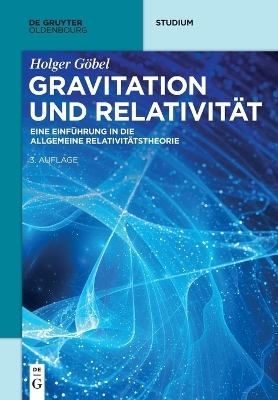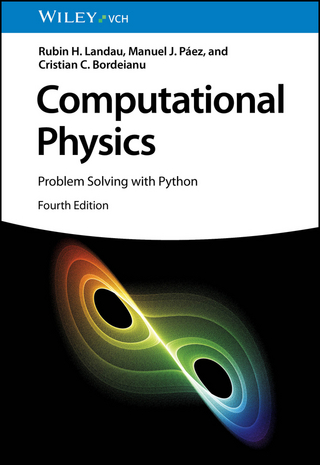Principles & Practice of Physics, Global Edition
Pearson Education Limited (Verlag)
978-1-292-36470-4 (ISBN)
For a strong, deep, and fundamentally simple understanding of physics
Eric Mazur's groundbreaking Principles and Practice of Physics establishes an understanding of physics that is thorough and accessible. Mazur's unique pedagogy and popular peer-to-peer instruction techniques incorporate insights supported by physics education research (PER) to help students develop a true conceptual understanding alongside the quantitative skills needed in the course. The material emphasises core unifying ideas with the first half of each chapter teaching the ideas using words and images - not mathematics. The second half of each chapter casts the ideas into quantitative and symbolic form.
The 2nd Edition integrates key features from the Practice volume into the Principles volume and provides all Practice volume content in Mastering Physics. The new edition provides new prelecture material that better prepares students to come to class ready to participate and supports instructors in building active and relevant lectures.
This product contains Volume 1 of Principles & Practice of Physics (Chapters 1-21) and Volume 2 of Principles & Practice of Physics (Chapters 22-34) Samples Download the detailed table of contents.
Preview a sample chapter from Principles & Practice of Physics, Global Edition Features
Conservation laws are the backbone of contemporary physics. The text develops conservation of momentum and energy before Newton's laws, and emphasises symmetry, conservation, and unity throughout. In mechanics, this approach avoids many of the pitfalls related to the concept of force, leads naturally to the two-body character of forces, and enables students to solve a range of problems before bringing in calculus.
Concept of a system is used explicitly and consistently throughout the text. Many ideas in physics depend on distinguishing system from surroundings and selecting an appropriate system is a key skill for solving many types of problems.
Both Galilean and special relativity help to explain many ideas of physics. This text introduces reference frames in Chapter 6, and it covers special relativity in Chapter 14, rather than at the end of the second semester.
Statistical treatment of thermodynamics in the text builds thermodynamics on a more logical and coherent foundation, starting with an accessible treatment of the statistical basis for entropy.
The structured learning architecture with research-based instruction help students learn physics
Each chapter is divided into a Concepts section and a Quantitative Tools section to help students build a robust understanding of the material instead of focusing too quickly on equations. The Concepts section develops the ideas in qualitative terms, using words and pictures and building from specific observations to general principles. The Quantitative Tools section formalises the ideas mathematically.
The core ideas of mechanics are developed in one dimension, helping students to concentrate on learning them before tackling the mathematical complexities of two-dimensional analysis. Chapter 10, 'Motion in a Plane,' introduces the second dimension.
Strong connection to experiment and experience. When possible, the text develops ideas from experimental observations that the student can make to help students work out the reasoning that leads from observations to principles. The text often reads like a dialog between author and reader, rather than the traditional authoritarian approach that states definitions and principles backed up with derivations and examples.
Strong visual instruction presents figures as visual explanations and ideas in visual terms. In accordance with research on visual instruction, visuals incorporate explanation and are quite schematic, highlighting key relationships and omitting unnecessary detail. If figures do not require a third dimension, they do not use one. Many figures show multiple representations that combine a situation sketch with a graph or bar diagram.
New to this edition An expanded user-friendly and interactive approach for students
Key features from the Practice volume now appear in the Principles volume, giving students access to content and features in one location.
Practice problems and Chapter Summaries are now located in the Principles eText.
All Practice volume content and features are now located in Mastering Physics.
Developing a Feel helps students to develop a quantitative feel for the quantities introduced in the chapter and to learn to make valid assumptions and estimates.
Worked and Guided Example videos give students the opportunity to review a worked example before they attempt to solve a similar problem. Hints and questions guide them through each problem. The videos are embedded in the eText and available for practice in the Study Area of Mastering.
Review Questions in the Pearson eText provide links that direct students to correlating places in the eText and interactive media and are assignable in Mastering Physics.
Self-check features are now interactive in the eText to engage students andare closely integrated into the learning program.
Checkpoint questions often serve as the springboard for the next phase of the discussion.
Each Concepts section ends with a Self Quiz that lets students test their understanding of the material before proceeding.
Eric Mazur is the Balkanski Professor of Physics and Applied Physics at Harvard University and Area Chair of Applied Physics. As an internationally recognised scientist and researcher, he leads a vigorous research program in optical physics and supervises one of the largest research groups in the Physics Department at Harvard University. Eric Mazur is author or co-author of over 300 scientific publications and holds three dozen patents. He has also written on education and is the author of Peer Instruction: A User's Manual, a book that explains how to teach large lecture classes interactively. In 2006, he helped produce the award-winning DVD Interactive Teaching. He is the founder of Learning Catalytics, a platform for promoting interactive learning in the classroom, which is available in Mastering Physics.
1. Foundations
2. Motion in One Dimension
3. Acceleration
4. Momentum
5. Energy
6. Principle of Relativity
7. Interactions
8. Force
9. Work
10. Motion in a Plane
11. Motion in a Circle
12. Torque
13. Gravity
14. Special Relativity
15. Periodic Motion
16. Waves in One Dimension
17. Waves in Two and Three Dimensions
18. Fluids
19. Entropy
20. Energy Transferred Thermally
21. Degradation of Energy
22. Electric Interactions
23. The Electric Field
24. Gauss’s Law
25. Work and Energy in Electrostatics
26. Charge Separation and Storage
27. Magnetic Interactions
28. Magnetic Fields of Charged Particles in Motion
29. Changing Magnetic Fields
30. Changing Electric Fields
31. Electric Circuits
32. Electronics
33. Optics
34. Wave and Particle Optics
| Erscheinungsdatum | 17.02.2022 |
|---|---|
| Verlagsort | Harlow |
| Sprache | englisch |
| Themenwelt | Naturwissenschaften ► Physik / Astronomie |
| ISBN-10 | 1-292-36470-X / 129236470X |
| ISBN-13 | 978-1-292-36470-4 / 9781292364704 |
| Zustand | Neuware |
| Informationen gemäß Produktsicherheitsverordnung (GPSR) | |
| Haben Sie eine Frage zum Produkt? |
aus dem Bereich




